Dogon Country
December 16, 2005
My kidneys will never be the same…
We ate lunch in Bandiagara (Bon-ja-gara). After that we set off for Sanga, a short thirty mile trip. The road to Sanga, however is really not much of a road. It’s one lane and dirt with rocks and holes and washouts about every six inches. We bounced and jostled down that road for two and a half hours before reaching our destination.
The surrounding countryside is amazing. The Dogons raise onions as their primary crop. There are many river valleys that wind through the escarpment. Several of these rivers have been dammed, creating good sized reservoirs for watering their crops. The fields themselves are terraced and well marked. We learned that there are individual fields as well as community fields. Men and women work to water, harvest, and replant these fields. We also encountered men weaving cotton thread into blankets and garments.
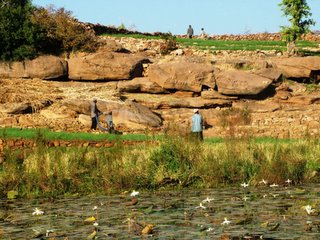 The Dogon villages are equally as amazing. They are tidy, organized, well kept little hamlets. Garbage is piled outside of the village and burned. Since the area is so rocky, there are many quarries and likewise many rock walls and buildings. There were very few dilapidated structures as the village seems to work together to maintain itself. This differs from other villages where the inhabitants seem to be on their own; if the resident of a structure can’t afford to rebuild, then the structure doesn’t get rebuilt. Overall we were very impressed with the Dogon and their way of life.
The Dogon villages are equally as amazing. They are tidy, organized, well kept little hamlets. Garbage is piled outside of the village and burned. Since the area is so rocky, there are many quarries and likewise many rock walls and buildings. There were very few dilapidated structures as the village seems to work together to maintain itself. This differs from other villages where the inhabitants seem to be on their own; if the resident of a structure can’t afford to rebuild, then the structure doesn’t get rebuilt. Overall we were very impressed with the Dogon and their way of life.
They originally lived throughout Mali, but retreated from the onslaught of Islam. They ran to the Bandiagara Escarpment, chased out the Tellems, and took up residence. The Tellems were cliff dwellers. Their homes were high up in the cliff walls. They hunted game and gathered food from the surrounding woods. After some time they built structures at the base of the cliffs and lived there as well. The Dogon have taken over the villages at the bottom of the cliffs, using the higher structures as burial sites. They have logged the entire valley and wiped out all of the game.
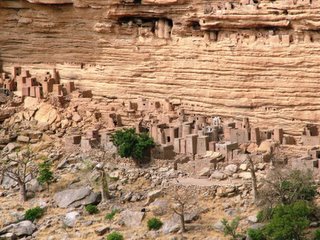 There are ten villages, each controlled by its own chief. All of the villages pay taxes and are controlled by the main village of Sanga. The leader of Sanga is elected by eligible men throughout the community. Most of the people are Muslim now, but there are a fair number of animists as well. This is a pagan faith which uses sacrifice, divination, and mysticism. The oldest member of the tribe is called the Hogan. He lives in a special house and is not permitted to bathe as they believe that the sacred snake will cleanse him when necessary.
There are ten villages, each controlled by its own chief. All of the villages pay taxes and are controlled by the main village of Sanga. The leader of Sanga is elected by eligible men throughout the community. Most of the people are Muslim now, but there are a fair number of animists as well. This is a pagan faith which uses sacrifice, divination, and mysticism. The oldest member of the tribe is called the Hogan. He lives in a special house and is not permitted to bathe as they believe that the sacred snake will cleanse him when necessary.


On our second day there we embarked on a journey down an even worse road then the first one. This was barely a track that wound down the side of the thousand foot cliff to the valley below. We made our way to the village of Tireli where we were treated to a Mask Dance. Usually performed at funerals, this dance involves thirty men in traditional dress and the most incredible hand made masks. It was extraordinarily beautiful, but ethically challenging. You see, we purchased the privilege of the dance for $250. Our guides defended the practice, quoting the influx of the almighty tourist dollar. It seems like prostitution though; selling ones culture for a fixed price. If that’s true, then we enabled them to take one step closer to the devil. How do traditional cultures maintain their identity while entering the twenty – first century?


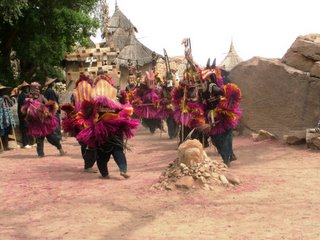
We ate a larrapin lunch and headed back up the hill, stopping once to check out the sacred crocodiles at another village. Our local guide, Gol – Fils was a fountain of information and provided us with answers to all of our questions. Like most Malians, he speaks five languages.

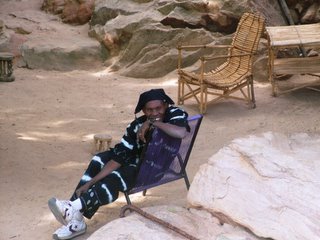
If I had a choice about where I wanted to live in Mali, I would choose Sanga. It is truly a community. They have irrigation systems, magnificent art, sanitation systems, and a true sense of community. They have long worked together to provide for their entire population. They are currently working to tar the road from Bandiagara to Sanga so they can attract more tourist dollars to their area. We are all saddened by this news as we have an understanding of what tourists can do to a culture. I hope that the Dogon can maintain their pride, their heritage, and their culture, while welcoming in the outside world.
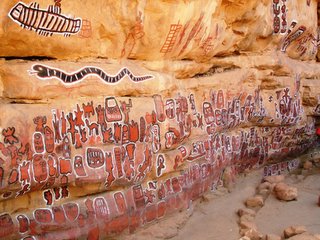

My kidneys will never be the same…
We ate lunch in Bandiagara (Bon-ja-gara). After that we set off for Sanga, a short thirty mile trip. The road to Sanga, however is really not much of a road. It’s one lane and dirt with rocks and holes and washouts about every six inches. We bounced and jostled down that road for two and a half hours before reaching our destination.
The surrounding countryside is amazing. The Dogons raise onions as their primary crop. There are many river valleys that wind through the escarpment. Several of these rivers have been dammed, creating good sized reservoirs for watering their crops. The fields themselves are terraced and well marked. We learned that there are individual fields as well as community fields. Men and women work to water, harvest, and replant these fields. We also encountered men weaving cotton thread into blankets and garments.
 The Dogon villages are equally as amazing. They are tidy, organized, well kept little hamlets. Garbage is piled outside of the village and burned. Since the area is so rocky, there are many quarries and likewise many rock walls and buildings. There were very few dilapidated structures as the village seems to work together to maintain itself. This differs from other villages where the inhabitants seem to be on their own; if the resident of a structure can’t afford to rebuild, then the structure doesn’t get rebuilt. Overall we were very impressed with the Dogon and their way of life.
The Dogon villages are equally as amazing. They are tidy, organized, well kept little hamlets. Garbage is piled outside of the village and burned. Since the area is so rocky, there are many quarries and likewise many rock walls and buildings. There were very few dilapidated structures as the village seems to work together to maintain itself. This differs from other villages where the inhabitants seem to be on their own; if the resident of a structure can’t afford to rebuild, then the structure doesn’t get rebuilt. Overall we were very impressed with the Dogon and their way of life.They originally lived throughout Mali, but retreated from the onslaught of Islam. They ran to the Bandiagara Escarpment, chased out the Tellems, and took up residence. The Tellems were cliff dwellers. Their homes were high up in the cliff walls. They hunted game and gathered food from the surrounding woods. After some time they built structures at the base of the cliffs and lived there as well. The Dogon have taken over the villages at the bottom of the cliffs, using the higher structures as burial sites. They have logged the entire valley and wiped out all of the game.
 There are ten villages, each controlled by its own chief. All of the villages pay taxes and are controlled by the main village of Sanga. The leader of Sanga is elected by eligible men throughout the community. Most of the people are Muslim now, but there are a fair number of animists as well. This is a pagan faith which uses sacrifice, divination, and mysticism. The oldest member of the tribe is called the Hogan. He lives in a special house and is not permitted to bathe as they believe that the sacred snake will cleanse him when necessary.
There are ten villages, each controlled by its own chief. All of the villages pay taxes and are controlled by the main village of Sanga. The leader of Sanga is elected by eligible men throughout the community. Most of the people are Muslim now, but there are a fair number of animists as well. This is a pagan faith which uses sacrifice, divination, and mysticism. The oldest member of the tribe is called the Hogan. He lives in a special house and is not permitted to bathe as they believe that the sacred snake will cleanse him when necessary.

On our second day there we embarked on a journey down an even worse road then the first one. This was barely a track that wound down the side of the thousand foot cliff to the valley below. We made our way to the village of Tireli where we were treated to a Mask Dance. Usually performed at funerals, this dance involves thirty men in traditional dress and the most incredible hand made masks. It was extraordinarily beautiful, but ethically challenging. You see, we purchased the privilege of the dance for $250. Our guides defended the practice, quoting the influx of the almighty tourist dollar. It seems like prostitution though; selling ones culture for a fixed price. If that’s true, then we enabled them to take one step closer to the devil. How do traditional cultures maintain their identity while entering the twenty – first century?



We ate a larrapin lunch and headed back up the hill, stopping once to check out the sacred crocodiles at another village. Our local guide, Gol – Fils was a fountain of information and provided us with answers to all of our questions. Like most Malians, he speaks five languages.


If I had a choice about where I wanted to live in Mali, I would choose Sanga. It is truly a community. They have irrigation systems, magnificent art, sanitation systems, and a true sense of community. They have long worked together to provide for their entire population. They are currently working to tar the road from Bandiagara to Sanga so they can attract more tourist dollars to their area. We are all saddened by this news as we have an understanding of what tourists can do to a culture. I hope that the Dogon can maintain their pride, their heritage, and their culture, while welcoming in the outside world.


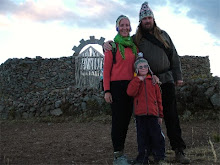

2 Comments:
Carrie and Mark - WOW - what amazing images, both through your writing and photos.
I think the $250 was money well spent. I don't see it as being any different than buying tickets to see a performance in a theater. I too hope that all communities can keep their traditions and not be spoiled by our ever growing global economy.
Thanks for all of your wonderful insights.
Hugs!
Anna
I think $250 is what Madonna charges for one of her shows. I'd definitly say the Dogon dance is money better spent but I know how thrifty you two are and ya didn't wheedle one of those costumes into the deal? Well..dogon.
Post a Comment
<< Home